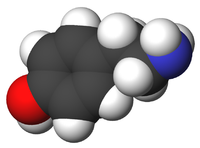|
HOME >>
Chemicals
>>
Chemicals List 2 >> Tyramine
Tyramine

Tyramine is a compound known as an amine found in
many foods, produced from the natural breakdown of the amino acid,
tyrasine. Tyramine can cause blood vessels to dilate, and this may
be what starts the migraine chain-reaction in some people.
Tyramine is a vaso-active amino acid found in foods. It precipitates
headaches in some sufferers. It is an intermediate product in the
conversion of tyrosine (an amino acid present in many proteins) to
epinephrine (an active hormone produced by the inner portion of the
adrenal gland).
Foods that contain tyramine may trigger headaches in migraineurs by
facilitating a chain reaction which results in selective cerebral
vasoconstriction followed by rebound dilation of the cranial vessels
(the most common cause of the throbbing headache pain). This
sequence of events is implicated in migraine headache.
Some of the foods containing tyramine are aged cheese, nuts,
herring, and chicken livers. A more complete diet listing is
available to members of the Foundation. Foods with high
concentration of tyramine are contraindicated with MAO1-type
antidepressants.
Tyramine is a common ingredient in over-the-counter fat loss
supplements because of its ability to increase dopamine levels, and
provide energy through the release of norephinephine - adrenalin.
Tyramine helps to induce fat loss by increasing adrenalin secretion,
by increasing muscular glucose uptake in the absence of simple
carbohydrates, thus eliminating or reducing the need for rises in
insulin levels.
For the dieting athlete, tyramines ability to increase glucose
uptake in the absence of simple carbohydrate means that insulin
spikes can be avoided and muscle glycogen stores can be restored
post-exercise.
Elevated insulin levels can lead to decreases in growth hormone,
IGF-1 and testosterone levels. Within the context of high bodyfat
percentages, elevated insulin levels will lead to a decrease in
protein synthesis, and an increase in muscular atrophy. Not good.
Dieting athletes know that controlling insulin is key to becoming
and staying lean.
Tyramine affects blood pressure, although clinical research
demonstrates that its effects upon blood pressure are mixed. Any
effects of tyramine on blood pressure is believed to result from
tyramines conversion into octopamine and synephrine.
Several trials have demonstrated that tyromine can be lipogenic -
fat forming - and can reduce the breakdown of fat. Again, clinical
research has not fully explored these findings and further research
is needed to understand fully the relationship between tyramine
administration and lipogenesis.
| |
|
Note /Government
Notification: These chemicals are designated as those that are
used in the manufacture of the controlled substances and are
important to the manufacture of the substances. For any (Control
Substance) products Import and Export *** subjected to your
country government laws /control substance ACT.
Information: The information on this web page is provided to
help you to work safely, but it is intended to be an overview of
hazards, not a replacement for a full Material Safety Data Sheet
(MSDS). MSDS forms can be downloaded from the web sites of many
chemical suppliers. ,also that the information on the PTCL
Safety web site, where this page was hosted, has been copied
onto many other sites, often without permission. If you have any
doubts about the veracity of the information that you are
viewing, or have any queries, please check the URL that your web
browser displays for this page. If the URL begins "www.tajapi.com/www/Denatonium
Benzoate.htm/" the page is maintained by the Safety Officer in
Physical Chemistry at Oxford University. If not, this page is a
copy made by some other person and we have no responsibility for
it.
The Controlled Substances Act (CSA) was enacted into law by the
Congress of the United States as Title II of the Comprehensive
Drug Abuse Prevention and Control Act of 1970.[1] The CSA is the
federal U.S. drug policy under which the manufacture,
importation, possession, use and distribution of certain
substances is regulated. The Act also served as the national
implementing legislation for the Single Convention on Narcotic
Drugs |
|
|
 New Chemicals New Chemicals
Diethyl ether,
Potassium permanganate,
Toluene,
Diethyl ether,
Potassium permanganate,
Methyl isobutyl ketone,
Para Anisyl Choride,
Methyl Tyramine,
Para
Cresyl Acetate,
Anisyl Formate,
Ortho Anisic Aldehyde,
3-Benzyloxy Propionitrile,
Veratrol,
Manganese Sulphate Monohydrate
|



